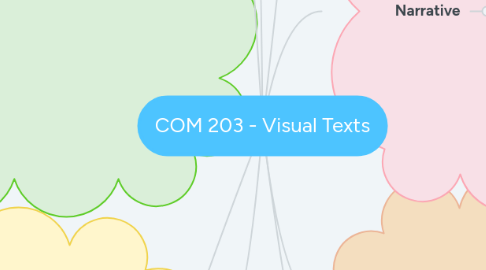
1. Denote & Connote
1.1. denotation
1.1.1. literal meaning of sign
1.1.2. interpreted based on background/culture
1.1.3. generally/broadly agreed upon
1.2. connotation
1.2.1. indirect/inferred meaning of a sign
1.2.2. relies on cultural/historical knowledge/experience to derive further levels of meaning
1.2.2.1. e.g DRAGON - fierce, powerful, son of god (king), secret society (gang)
1.2.2.2. e.g WHITE - political party, surrender, purity
2. Syntagms & Paradigms
2.1. syntagms
2.1.1. linear, sequential combination of signs which create a meaningful pattern
2.1.1.1. A happens, which leads to B happening, which leads to C happening, and so on.
2.1.1.2. Create compositional flow
2.1.1.2.1. You design a product page in a way so the first thing a visitor sees is the image of the product, because the image has the most visual weight on the screen. The element with the second most visual weight might be the name of the product, followed by a short description and then a price with an “add to cart” button.
2.1.2. syntagmatic analysis - what we can see (literal meaning)
2.1.2.1. e.g the airplane flew over the building
2.1.2.2. change noun & verb within a sentence but order of words stay the same
2.1.3. Syntagmatic relationships are about positioning.
2.1.3.1. e.g proxemics of things, foreground/background,
2.2. paradigms
2.2.1. selection of acceptable words to use in the sentence
2.2.2. paradigmatic analysis - underlying meaning
2.2.2.1. e.g Black people with Afro hairstyle are uncivilised. They need to dress and recivilise like white people by using NIVEA products that gives the whitening effect
2.2.2.2. e.g 4 men, 1 women - women in submissive & suggestive position; looks uncomfortable from facial expression
2.2.3. Paradigmatic relationships are about substitution.
2.2.3.1. e.g choice of colour, font size/type, gender of model, product
3. Metonym & Metaphors
3.1. metonymy
3.1.1. uses association; a phrase that is indicative of & associated to an actual concept
3.1.1.1. e.g shoulder to cry on = person I can confide in
3.1.1.2. e.g HOLLYWOOD = film industry
3.2. metaphors
3.2.1. uses substitution; similar qualities to link/refer to unrelated objects/subjects
3.2.1.1. e.g HOLLYWOOD = sex, drugs, glamorous (OSCAR awards), prestige (famous & rich lives there)
3.2.2. transferring known qualities of one referent to another
3.2.2.1. e.g night owl = qualities of an owl, nocturnal creature, person who stays up late
4. Peirce's concept of signs
4.1. icon / iconic
4.1.1. physical similarities between a sign & its object
4.1.1.1. e.g smiley face = delighted face
4.1.1.2. e.g drawing of a tree
4.1.2. visual representation of what the advertisement is trying to get across to their audience
4.2. index / indexical
4.2.1. sign that indicates/points to something which it stands for and shares some association/connection
4.2.2. causal relationship
4.2.2.1. e.g holding hands = kindship / caring / control over actions
4.2.2.2. e.g leaf
4.2.3. show evidence of what's being represented
4.3. symbol / symbolic
4.3.1. represents an object to which it bears no visual resemblance
4.3.2. meaning is arbitrary and has to be learned
4.3.2.1. e.g the word 'TREE' in English or any other languages
4.3.3. representation through cultural conventions
4.3.3.1. e.g dove bird = peace
5. signs
5.1. signifier (material)
5.1.1. something physical and concrete which we associate with some idea/concept
5.1.1.1. e.g Angelina Jolie is a signifier of exotic beauty & embodies class, sophistication, intellect
5.1.2. thing, item, or code that we ‘read’ – so, a drawing, a word, a photo
5.2. signified (immaterial)
5.2.1. idea or meaning being expressed by that signifier
5.2.1.1. E.g word ‘cool.’ If we take the spoken word ‘cool’ as a signifier, what might be the signified? In one context or situation, cool might refer to temperature. But in another, it might refer to something as ‘stylish’ or ‘popular’. The relationship between signifier and signified can change over time and in different contexts.
5.3. Characteristics of signs
5.3.1. coded: make rules to associate signifiers with signified
5.3.2. polysemic: can have more than 1 meaning
5.3.3. dynamic: meanings change with time & place
5.3.4. arbitrary: agreed upon by conventions that are culturally shared
6. Relay & Anchorage
6.1. relay
6.1.1. text provides additional info that suggests possible interpretation that is not conveyed by the original image (extends meaning)
6.1.1.1. e.g photo captions / speech bubbles / flim dialogue
6.2. anchorage
6.2.1. text that fixes the meaning of a image/ points out the most important meaning to guide interpretations
6.2.1.1. e.g title / captions / labels that answers "what is it?"
6.3. textual text
6.3.1. can be both relay & anchorage
7. Mise-en-scene
7.1. setting & props
7.1.1. e.g big painting, tv, comfy sofa = middle-class family
7.1.2. e.g giant speakers = child crying fpr desire to be heard
7.2. costume, hair, make up
7.2.1. tells about character's age & job
7.2.2. character's features & how it complements their role/emotions
7.2.3. period of time
7.3. facial expression & body language
7.4. lighting
7.4.1. e.g lamps on - light shine on parents, child in the dark = neglected
7.4.2. e.g shadows = menacing, reaching out to other character
7.5. frame
7.6. character placement (proxemics)
7.6.1. e.g girl in background less power than man in foreground, wearing suit
7.6.2. e.g distanced, far away = not a close-knitted family
8. Narrative
8.1. causality
8.1.1. cause and effect that propels story forward
8.1.1.1. e.g childhood to old age (even if its not shown)
8.2. time
8.2.1. story time (time period of whole story)
8.2.2. plot time (time period covered in the film)
8.2.3. screen time (length of film)
8.2.4. order of events
8.2.5. duration of events
8.2.6. frequency
8.3. space
8.3.1. everything you see in a still frame
